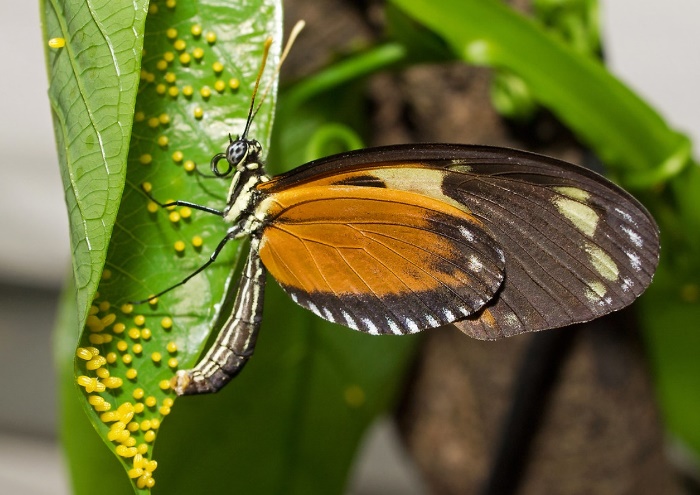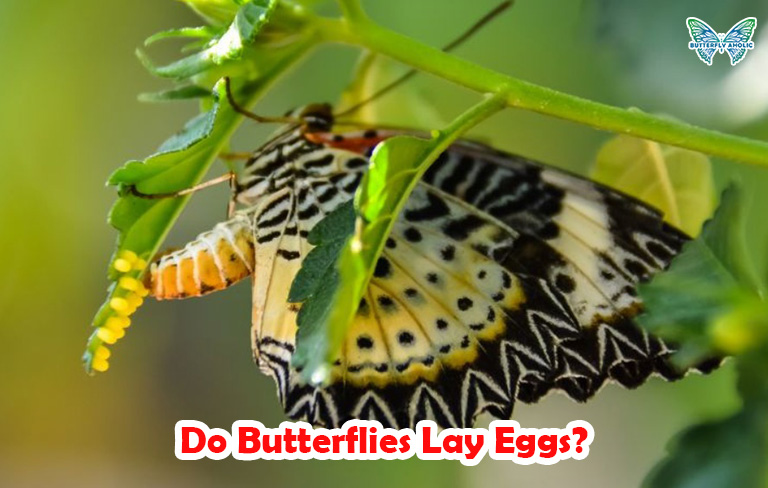Do Butterflies Lay Eggs? When, Where, and How Many?
Butterflies lay eggs as a mandatory part of their life cycle and their form of reproduction.
The appearance of butterfly eggs varies greatly depending on the species, but they can be round or oval shapes with the diameter remaining within the range of 1 – 3 millimeters.
The spectrum of the colors is quite broad too, from plain white to bright yellow or deep green.
When you observe the eggs through magnifying glasses, you can also see if the surface is textured or smooth, making butterfly eggs a quite magnificent sample to study.
What you will learn after reading this article:
- Seasons for butterflies to lay their eggs
- How female butterflies find the place to lay eggs
- How butterfly eggs are formed and laid
- Total number of eggs a butterfly can lay
- What female butterflies do after laying
More Facts On Butterfly Egg-Laying
The tiny eggs might seem easy to overlook at first sight, yet the cycle they go through is complex, with more mysteries than one might imagine.
Observing the entire process of butterflies mating and laying eggs is certainly an experience like no other!
When
Butterflies have spring, summer, and fall as their mating seasons. They have their most and least favorable time for mating as well, which varies for each species.
However, most butterflies are inactive in winter, hence reproducing is out of the equation for them.
A typical butterfly species can have at least 4 generations per year. And, the last generation will be facing the cold, harsh winter and have to relocate for survival.

Love butterflies, check now: Butterfly Footwear & Butterfly Home Decor
Where
The female butterfly is responsible for finding a host plant to lay her eggs safely.
Unlike mature butterflies, the caterpillars born from these eggs can only consume certain trees or parts of those trees, hence the female needs to be extremely careful about it.
After finding a suitable plant (through the shape and color of its leaves), the female butterfly will check once more by tapping and scratching the surface of the leaf with her feet.
That special action will have the plant release an odor she can recognize and confirm.
We can take the famous Monarch butterfly as an example.
Like most butterflies and moth species, they will not stay and take care of their offspring, but they strictly lay eggs on milkweed plants, which provide shelter and food for the newborn caterpillars to feed, grow, and shed skins for two consecutive weeks.
Although we often find butterfly eggs on the leaves, it is mostly because this spot is easier to find. Actually, butterflies prefer laying eggs on the stems and the underside of leaves because it provides better protection against predators and unfavorable weather conditions.
Read more: What Do Butterflies Eat In The Wild?
The process
First of all, the male needs to determine whether the female is the same species or compatible with him based on the patterns and colors of her wings.
Once confirmed that the target is approachable, he will fly above or behind the potential mate and release his pheromones.
The next step is the courtship dance.
Combined with the pheromones, the male will flutter his wings and fly in species-signature patterns to seduce the female.
Meanwhile, the female also judges the male’s capability by his scent and strength. If interested, she will return the gesture!
When mating, the butterflies will adhere their abdomens together so the male’s sperm can be transferred to the female and preserved in the tube where eggs will pass through later and become fertilized.
While the eggs are still forming in her body, the female butterfly needs to look for a plant to lay eggs right after mating.
The eggs are covered in a type of wax for moisturization, yet this coating allows the male’s sperm to infiltrate through the micropyles (funnel-like openings) and fertilize the eggs.
The female’s body will produce a sticky substance that keeps the eggs where they are and thus protects them.
How many eggs
Some butterfly species, such as Monarch, lay single separate eggs, which might make them harder to find.
They will continue laying eggs over 2 – 5 weeks, and the quantity will be 300 – 500 eggs for one female individual. The highest number recorded is 1,179 eggs in total and 205 eggs in one day!
Meanwhile, other species lay clusters of eggs with a few layers. They might also drop their eggs while flying over terrain.
The large quantity is believed to ascertain the maximum number of caterpillars being born because not all eggs will hatch successfully.
Butterfly after laying
After laying eggs, butterflies can continue their life cycle, which lasts for about 4 – 6 weeks, except for the generation born near winter. This generation will migrate and attempt to find better places to live, though the harsh conditions they encounter on the way may very well kill them.
Like humans, butterflies will die when they are old enough, given that they are not attacked.
Scientists discovered a fascinating fact that female butterflies still have many eggs inside them when they die, which means the number of eggs we have recorded on them is still far from their actual capability.
As a new cycle begins, young butterflies tend to not start mating within the first 3 – 5 days of having their adult form.
The Takeaways
Butterflies lay eggs for reproduction, and this process guarantees their uninterrupted life cycle.
After about four days, in real-time, the eggs will hatch and release the caterpillars from the shelter.
The caterpillar will consume the shell of its egg first because the shell contains nutrients and continues to sustain with its host plant as food until it becomes an adult butterfly and can find other food sources.

